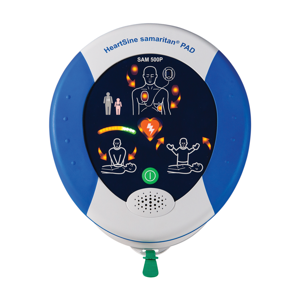Emergency Response And Resuscitation AEDs
Are you equipped to save a life?
Early intervention gives cardiac arrest victims the best chance of survival.1
What is sudden cardiac arrest?
Cardiac arrest is when your heart stops beating abruptly. This is different to a heart attack, where blood flow to the heart is blocked but the heart keeps beating. Cardiac arrest is a leading cause of death in New Zealand and can happen to anyone, anywhere at anytime. For every minute defibrillation is delayed, the patient's chance of survival reduces by approximately 10%.2 Therefore early response is key.
Statistics of sudden cardiac arrest in New Zealand.
- Each year, over 2,000 New Zealanders are treated for cardiac arrest outside of a hospital. Tragically, only 11% survive.3
- The average time for Hato Hone St John ambulance to reach a patient was 9 minutes in urban communities and 11 minutes in remote ones.3
- In 76% of cases, a community responder starts CPR, but an AED is only used 5% of the time.3
- Outcomes from cardiac arrest are most favourable when the patient receives immediate CPR and defibrillation within the first five minutes.4
- Reducing response time by even one or two minutes from collapse to shock can be the difference between life and death.5
What is an Automated External Defibrillator (AED)?
An AED is a small, electronic device that helps people deliver life-saving defibrillation (electric shocks to the heart) to cardiac arrest victims. Whilst intervening in an emergency can be intimidating, AEDs are designed so that anyone can use them and save a life.
Why have an AED in your business?
Cardiac arrest can happen to anyone, anywhere, at any time. Fast access to an AED can help you save a life. Therefore, having an AED nearby gives you, your work colleagues, your family, and your community a potential lifeline if they were to suffer from one.
Which AED is right for you?
Choosing the right AED for your organization will depend on a number of factors.
- Who are you purchasing the AED for? Is it for your personal use (in your car or home) or is it for your organisation or workplace?
- How large is your site and are you spread over several floors?
Things to consider when choosing an AED:
-
How quickly could a team member get to an AED?
-
Do you have multiple sites?
-
Will the AED be exposed to water or dust?
-
Do you have team members trained in first-aid?
-
Do you work in a noisy environment?
-
Is price a consideration?
Explore our range of Public Access AED Solutions.
Explore our range of Public Access AED Solutions.
HeartSine AED's
HeartSine Defibrillator SAM 360P - Fully Automatic
Cost-effective and easy-to-use, with only one button operation!
Designed to be durable, affordable and highly portable, the HeartSine SAM 360P fully automatic is easy to use, has a high level of environmental protection, and comes in the smallest and lightest package available among leading Automated External Defibrillators.
HeartSine Defibrillator SAM 500P - Semi Automatic
Real-time CPR feedback on the force and rate of compressions.
The HeartSine SAM 500P semi-automatic meets the needs of two key links in the chain of survival - not only does it deliver a life-saving shock, but it also provides real-time visual and verbal feedback on the force and rate of CPR compressions, effectively assisting the rescuer to perform quality CPR.
LIFEPAK AEDs
LIFEPAK CR2 Essential - USB - Semi Automatic
Layered, easy-to-follow design for the minimally trained first responder!
For a minimally trained responder, intervening in an emergency can be intimidating. The LIFEPAK CR2 Automated External Defibrillator (AED) Essential is designed for user confidence - with simple graphics, audible instructions and automated features, users have the tools they need to help save a life.
LIFEPAK CR2 - WiFi - Semi Automatic
Upgrade your approach in defibrillation with online management!
AEDs are effective only if they are close at hand and ready to work. The LIFEPAK CR2 Automated External Defibrillator (AED) uses LIFELINKcentral AED Program Manager to monitor each connected CR2 and alerts you to anything that may affect device readiness (e.g. battery, location, servicing, etc.) This helps prevent unnecessary delays and gives even minimally trained first responders with the tools they need to save lives.
Contact Us
Please see our range of AEDs on offer below. For more information contact: MedicalEmergency@pharmaco.co.nz, 0508 414 564
References
- Out-of-hospital Cardiac Arrest Registry Summary Report 2021/2022. All OHCA attended by the Hato Hone St John and Wellington Free Ambulance EAS 1 July 2021 to 30 June 2022.
- Australian and New Zealand Committee on Resuscitation. ANZCOR Guideline 7 - Automated external defibrillation in basic life support. The ARC Guidelines 2021. https://resus.org.au/guidelines/.
- Out-of-hospital Cardiac Arrest Registry Summary Report 2022/2023. All OHCA attended by the Hato Hone St John EAS 1 July 2022 to 30 June 2023.
- New Zealand Resuscitation Council, Become a Good SAM. Promoting a community of lifesavers. https://www.resus.org.nz/public-resources/
- Mosesso Jr VN, et al. 2002. Proceedings of the National Center for Early Defibrillation Police AED Issues Forum. Prehospital Emergency Care. 6 (3):273-82.




